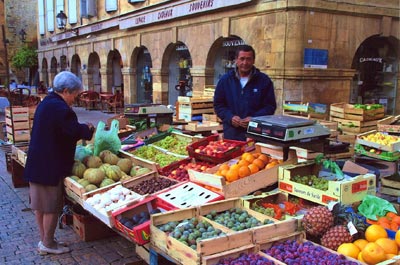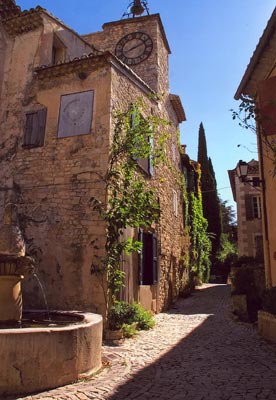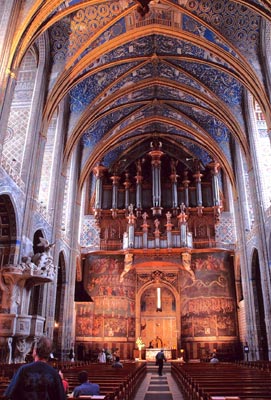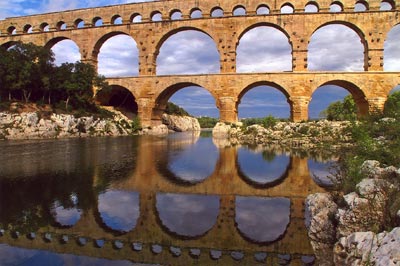France — from the Dordogne to Provence: minimizing the crowds and maximizing the enjoyment
by Fred DeVinney, photos by Jean DeVinney, Oakland, CA
The guidebooks and some friends had warned us about the huge crowds and endless souvenir shops that can ruin the experience of some French villages that are just too spectacular and/or charming for their own good. Rocamadour, near the Dordogne region, and Les Baux-de-Provence are two prime examples of these very popular, often overrun, stunning villages. But these two locations ended up being among the highlights of our 2006 trip to France.
Avoiding the crowds
By arriving in the Dordogne in late September, my wife, Jean, and I had already avoided the worst of the high-season crowds. Our main strategy, though, was to spend a night in each of the very popular villages, arriving mid- to late afternoon, when the tour buses and crowds were departing, and leaving mid- to late morning when the crowds were just arriving.
Most of these villages have limited accommodations, and in the evening, when most of the curio shops were closed, we would have a nice, quiet picturesque village to enjoy without crowds.
The French do a wonderful job of lighting everything at night, and my fondest memories of our trip are of the nightly after-dinner walks, with the ethereal play of shadows and light along the cobblestone streets of these beautifully preserved villages and the awesome spectacle of fl oodlit castle walls, cathedrals and châteaux.
Making reservations
I reviewed Rick Steves’, Frommer’s and Fodor’s books to come up with the places we would visit. Through a combination of their recommendations, it was easy to make a list of the destinations they considered the most important. In fact, they were pretty much in agreement on most.
All hotel reservations were made in advance, again using the input of all three sources plus www.tripadvisor.com. The latter rates hotels all over the world by city, based on feedback from members (free). Reader reviews are also printed for each hotel.
For our 12 nights in France, we spent two nights in three different destinations and one night in six. The driving distances were, in the main, quite short, but to reduce the hassle of moving frequently we felt it was essential to make reservations everywhere.
What we gave up in flexibility was more than made up for by never having to feel stressed or waste time looking for a hotel. We could linger somewhere we were enjoying or squeeze in another place and arrive late if we chose.
The small villages and midsized cities usually had the names of the hotels and arrows pointing to them as we entered. I had made reservations for late September in May and even then found some hotels already filled.
Rocamadour
After spending a week and a half in other cities using a limited Eurailpass, we arrived in Brive via train from Paris and picked up our rental car at Europcar, across the street from the station; it had been arranged by Auto Europe (Portland, ME; 888/2235555).
It was a little over an hour’s drive to Rocamadour, where we checked into the very nice and highly recommended Hotel Beau Site Rocamadour (www.bw-beausite.com), at €90, or $124, for a double. (Breakfast, which was extra here, is rarely included in any hotel’s quoted price but is always available.) We booked this hotel by phone through Best Western (800/428-2627).
Its restaurant has been a family-run affair for years and was excellent. Roast leg of lamb carved from the cart at our table was one of the best meals of our trip. Dinner cost €32 ($44). (Meal prices quoted are for two, without wine, which usually added €10 to each bill.)
Rocamadour is an amazing medieval village that defies the law of gravity, clinging to a 492-foot cliff. While you can drive to the village, it requires a steep climb to enjoy the pilgrimage site, with chapels, basilicas, crypts, and the upper ramparts where the views are breathtaking.
Rocamadour floodlit at night is truly spectacular. Walk out through the front gate and down a bit to truly enjoy the night illumination or inquire about the Petit Train that goes out across the valley each night to allow a look back on this dramatic sight. We learned about it too late.
The Dordogne
In the late morning, we left Rocamadour and enjoyed a short, scenic drive to the hilltop village of Domme for lunch, taking in the sweeping views of the beautiful surrounding countryside. A 10-minute drive from Domme brought us to La Roque-Gageac, a beautifully preserved village along the Dordogne River.
After a walk through this charming tiny village, we opted for a one-hour boat trip to Beynac and back, viewing La Roque and châteaux along the way.
It was only a few minutes’ drive back to Beynac, another wonderfully restored town, with the dramatic Château de Beynac perched on top of a steep cliff. After walking through this lovely village up to the château, we decided, as it was close to 6 p.m., to return another day.
With a reservation in nearby Sarlat, we were able to spend our late afternoon in Beynac and arrive close to 7 without the hassle of having to find a hotel. We checked into a nice room with balcony (€115, or $158) at Hôtel de Selves (www.selves-sarlat.com), a very good hotel with easy street parking and a pool and located about 10 minutes’ walk from the Old City.
Place de la Liberté, the old market square, is a nice place to hang out or have a drink before dinner.
On our second night, we had a very good 3-course dinner for €34 at La Couleuvrine hotel’s elegant dining room (with a nice wine bar as you enter). The hotel looked very atmospheric and was located right on the edge of the historic center. It was my first choice but was booked when I contacted them four months in advance. It was also less expensive than the Selves.
Prehistoric paintings
Our next day was to be devoted to the prehistoric caves and their splendid paintings, which date back to 17,000 B.C. We started at Grotte de font-de-Gaume, which appeared to be the favorite of the sources we consulted. I highly recommend that if you plan to visit more than one, see this one first, as tours are available in English.
We were fortunate to have a guide totally devoted to his work. Our tour here gave us an excellent foundation for our number-two choice, nearby Grotte de Rouffignac, where there were only French-language tours. With a good understanding from our first cave, we could just relax and enjoy the paintings.
We finished at Rouffignac about 4:00 and were heading back to Sarlat when we decided to go to the famous Lascaux II, which was not far out of the way. While this is a replica of the original, which was closed down for preservation many years ago, the replica has been painstakingly reproduced and was very impressive, indeed.
It was late in the day and there were no more English tours, but, again, this was a visual experience and we thoroughly enjoyed it.
The next morning, Wednesday, was a market day in Sarlat. Held in and around the Old Town square, this market was the fi rst of many we would encounter, each providing a nice way to enjoy the local ambience and allowing us to sample and purchase local foods and crafts.
Beyond Beynac
We decided that rather than return to see the inside of the Château de Beynac we would visit Castelnaud, across the river. While the former offers an imposing view soaring 500 feet over the Dordogne River, one guidebook indicated the latter was more impressive inside.
With videos, interactive computers, castle models and a wide array of weapons and catapults, it was most impressive and provided a real insight into medieval castle life and warfare.
After lunch in Beynac, we headed for tiny St.-Cirq-Lapopie. Rick Steves advises to “beg, borrow or steal” a night here and we wholeheartedly agree.
Hôtel de la Pélissaria (perso. wanadoo.fr/hoteldelapelissaria), at €106 ($146), is a charming 10-room hotel built on a hillside with gardens and terraces. Our nicely furnished room (No. 6) came with a piano!
From the terrace, we had a terrific view of this picturesque village with its cathedral and fortress ruins clinging to the hillside far above the River Lot. Drinking in this splendid ambiance, and with haunting strains of Mozart running through my head, I sat at the piano and cursed the day I gave up lessons before we set off to explore this gem of a village.
The next morning we hiked down the 600-foot-long path leading off the main square and took a very scenic walk along the river. The weather was warm and sunny and we left regretfully, thinking an additional day might have been nice. On the other hand, if it had been raining there would not have been a lot to do here, confirming that one night in these very small hill villages is probably best, overall.
Toulouse-Lautrec
After the scenic villages of the Dordogne, our next destination, Albi, was at first a bit of a letdown. It is a fairly large city, with all the traffi c and bustle that goes with that, but we quickly readjusted. After all, we were there primarily to see the Musée Toulouse-Lautrec and the massive, fortress-like Ste. Cécile Cathedral. With a splendid interior, this enormous cathedral is a “must visit,” and, like so much in France, it’s very impressive lit up at night.
For those who think of Toulouse-Lautrec only as the artist who painted the famous posters of the Moulin Rouge, you are in for a treat. Lautrec was an accomplished artist of multiple dimensions, and the greatest collection of his works is displayed here in his place of birth. The audio guide brings Lautrec and his era to life.
The Hostellerie St. Antoine (www.saint-antoine-albi.com), with rooms at €100 ($138), was excellent and located just off the center square near all the main attractions. There is also an interesting market on Saturday mornings here.
Carcassonne
Leaving Albi around noon, we headed for the medieval walled city of Carcassonne, two hours away. We had made reservations at Hôtel le Donjon (800/428-2627, www.hotel-donjon.fr), costing € 140 ($193), which friends had highly recommended. We enjoyed a nicely furnished large room, with a garden patio, in the annex.
There are not a lot of hotels within the walls, and being inside the walled city added immeasurably to our enjoyment of Carcassonne. When arriving at the parking lot just outside the walls, you are required to show your reservation within the walls to park there. The lot guard, who was angry because we could not speak French, was the only rude person we ran into in France.
The inner walls are accessible only by tour — an excellent way to start your exploration of Carcassonne. Tours of approximately an hour, many in English, are available throughout the day from near the center of town and cost about €8 each.
We took a walk around the outer walls during the day and again at night, with the latter being the highlight of Carcassonne, as the massive medieval walls were flooded with light. While outside the walls, walk down to the old bridge below, the Pont-Vieux, to look up at this awesome sight.
We enjoyed a very fine dinner (€30) at the small and atmospheric l’Auberge des Lices, well hidden on a small street near our hotel.
On to Arles
It was about a 2-hour drive to Arles, which is a good place to center while exploring the western part of Provence. At €72 ($99), Hotel de l’Amphitheatre (www.hotelamphitheatre.fr) was certainly the bargain hotel of the trip, with pleasant, clean rooms plus a very nicely decorated sitting area and breakfast room off the lobby. We enjoyed two excellent breakfasts at about €8 each.
The location was ideal, close to the forum square and the Roman amphitheater, both impressively illuminated at night. Easy side trips can be made to the Pont du Gard and the tiny village of Les Baux, both “must sees.”
It was time to relax a bit — sit at a café, gaze at the amphitheater and do nothing.
But don’t miss the museum of ancient history, a 20-minute walk out through the walls and along the river. Splendid models and recreations of Roman life, mosaics, sarcophagi and artifacts all make this an exceptional museum.
An easy 10-mile drive brought us to the tiny clifftop castle town of Les Baux, which sees over 1,000,000 visitors a year. It’s no wonder that some friends who had arrived midday during the summer months had turned around and left. But it was now October and I doubt if even midday would have been all that bad. Nevertheless, we arrived close to 4 p.m. and found it relatively peaceful. We headed straight for the castle ruins and, with the aid of an audio guide, enjoyed almost two hours of history plus spectacular views from this rocky plateau.
Then it was time for dinner at the only hotel inside the gate, Hostellerie de la Reine Jeanne. Since we had made a reservation, we were given a table with a view. A fine 3-course meal (€30) was topped off by a warm, dark-chocolate cake with fudge running out of the center. It was to die for (and maybe from)!
While we broke our rule of staying the night, we did pretty much the same as in the other villages by staying for dinner and taking a peaceful walk afterward. We encountered two people and four dogs — a far cry from the hoards of high season. The short drive back to Arles was well marked and easy.
The aqueduct of Pont du Gard is fewer than 45 minutes from Arles. This massive structure, spanning a canyon, is one of the best-preserved Roman ruins surviving today. Admission is free and you can walk under, around and above to view this magnificent structure.
The museum here was a great addition to visitors’ understanding this massive undertaking and provided a splendid interactive visual on how water and hygiene played such an essential part of Roman life.
Côtes du Rhône
Rick Steves, in his guidebook “Provence and the French Riviera,” intrigued us with his recommendation of a driving tour of the villages of the Côtes du Rhône, northwest of Avignon. This is wine country, and Vaison-la-Romaine, the largest of some very tiny villages, looked like (and turned out to be) the ideal place to stay.
Hostellerie le Beffroi (www.lebeffroi.com), at €135 ($186), was one of our favorite hotels and where we reserved one of the larger rooms, tastefully furnished, with a sweeping view of the valley below.
As we got to the village entrance, the streets were so narrow we felt we shouldn’t drive in. I walked the short distance to the hotel, where they told me that parking was available. I think it’s best to let them know in advance if you will need parking.
This relaxing, pleasant village of cobblestone streets and Roman ruins was delightful to explore.
We continued to follow Rick Steves’ drive through the tiny, picturesque villages of Suzette, Lafare, Beaumes-de-Venise and Vacqueyras, some so small you could cover them on foot in 10 to 15 minutes.
There are numerous places to stop to sample the local Côtes du Rhône wines, including Gigondas, a slightly larger village with more to explore. The whole circular route is approximately 40 miles and could be done in a few hours or a couple of days, depending on how much you wish to explore or how much wine tasting you wish to do.
We chose not to return to Vaison la Romaine but to move on to Roussillon in the Lubéron region, a little over 90 minutes from Séguret, our last stop.
Village visits
Roussillon, a very pleasant village located 1,000 feet above the vineyards below, is known for its ochre cliffs and orange-hued canyon. On a walk through this area, one encounters numerous artists with their easels attempting to capture the many moods and rich colors of this scenic canyon.
Our hotel, Las Mas de Garrigon (www.masdegarrigon-provence. com), with rooms at €107 ($147), was about four miles out of town in a very pastoral setting. We had a nice room with a patio, but we felt their dinner, offered at €40 ($52) each, and breakfast, at €15 ($21), were overpriced. We had dinner in town and, as quiet as things were this late in the season, we probably would have preferred to stay in one of the small hotels in Roussillon.
A 30-minute drive the next morning took us to Isle-sur-la-Sorgue, where we had breakfast and enjoyed the lively Thursday morning market. They also have a market on Saturday. Before heading to nearby Orange, we enjoyed a scenic walk along the canals, locating some of the large waterwheels used in the textile mills of the 18th century.
Orange’s splendid Roman theater is considered the best preserved in Europe. A recorded self-guided tour was essential to absorb its history and ambience. Do not miss the movie that depicts the history and performances held in the theater.
The Arc de Triomphe is also worthwhile if you have time. It is only about a 15-minute walk from the theater, so it’s not worth moving your car, as the area surrounding it is quite congested.
Orange is a large city, but the route to the Roman theater is well marked, providing easy access. I see no reason to linger in Orange beyond visiting these sights.
Avignon
Avignon, where we turned our car in near the main train station, was about an hour away. Europcar closed at 6 p.m., and we got our car back to them just as they were closing. I never thought to check on closing times when making reservations.
After finding five hotels that I had chosen from the guidebooks filled, I checked out www.tripadvisor.com and found La Banasterie (www.labanasterie.com). Our room cost €140 ($193), with a wonderful breakfast included. This gem of a small hotel, on a quiet street, was ideally located a short walk away from all the major sights. Our tastefully decorated room came with chocolates and a basket of fruit.
It was close to 7 p.m., and the owner, Jean-Michel, was most helpful in making suggestions and securing dinner reservations for that evening and the next night. Both the sleek, modern Les 5 Sens (€40) and more traditional La Fourchette (€37) were excellent.
We arrived home each night to the warm atmosphere of candles within the small lobby and lining the steep spiral stairway.
The 14th-century Gothic Palace of the Popes dominates the landscape of Avignon, and it is worth touring, although it is somewhat spartan inside. The self-guided audio tour does bring it all to life.
The ramparts and the St. Bénezet Bridge all can be visited with the ticket to the palace. The park above is a delightful place to savor the views, have a picnic or just relax, read and enjoy, as we did.
Avignon at night is another visual feast, with the ramparts, bridges, splendid buildings of the main square, Place de l’Horloge and the enormous Palace of the Popes bathed in light. And, on our visit, a final touch — a full moon was rising over the twin steeples of the latter.
Looking back, we would have changed little, outside of spending another night in Vaison La Romaine. The enjoyment of our trip was enhanced immeasurably by making reservations in advance and arriving relaxed to enjoy the nights in places that can be overrun with tourists midday.
I would be happy to try to answer any questions; e-mail us c/o ITN.





